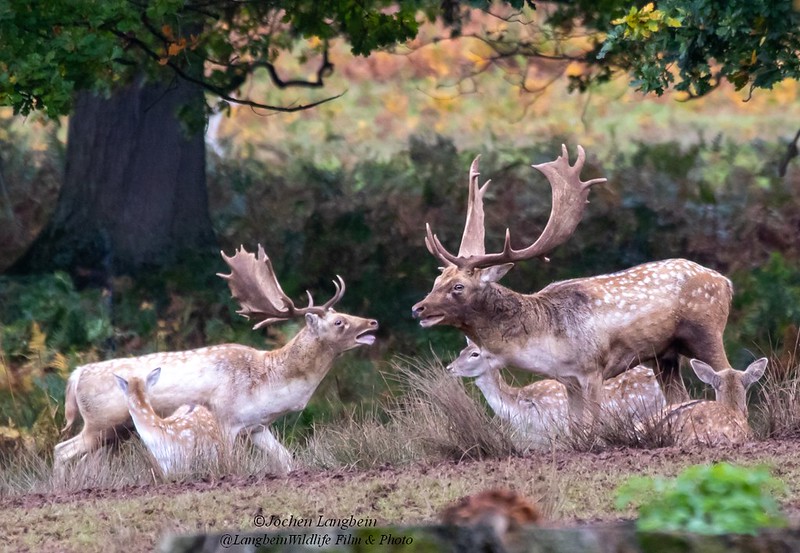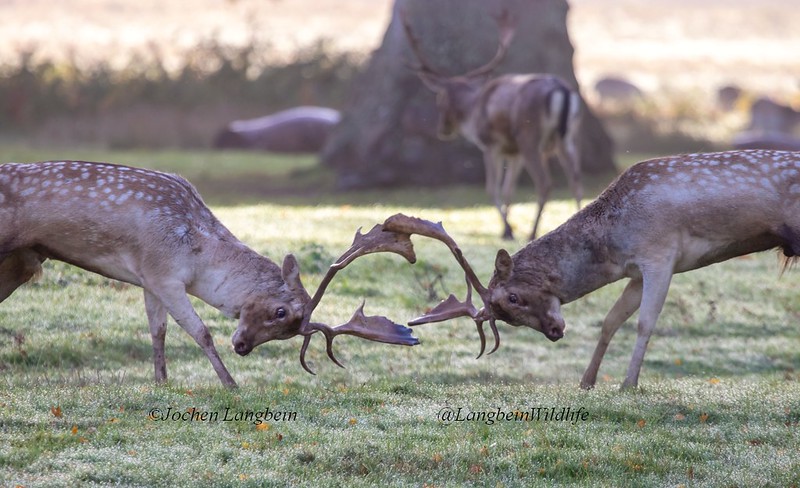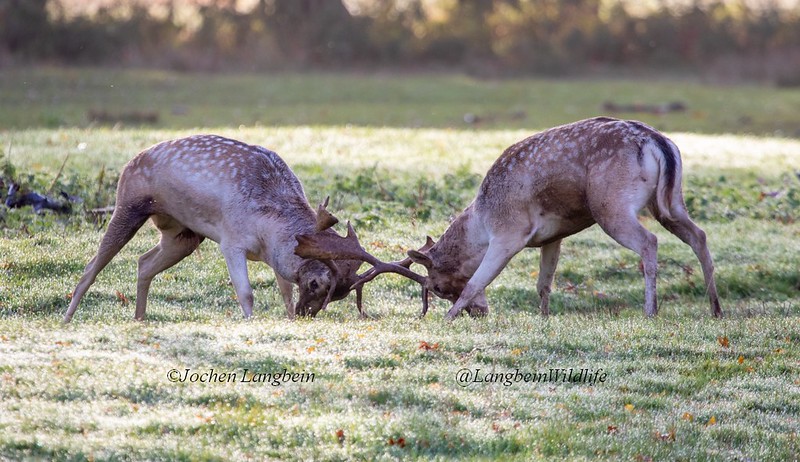In Britain the peak period for fallow deer mating activity, the ‘rut’, usually occurs between early October to early November. The fallow rut can provide a fascinating spectacle including a wide array of ritualised displays and fighting behaviour. Having spent two full days filming and photographing the rut in October 2022, this photo blog shows a range of photos (mostly from Powderham Castle estate) to illustrate some of the main rut behaviours: including (i) Groaning (ii) Challenging rivals and scraping ground (iii) Parallel Walking (iv) Fighting (v) Territory systems and (vi) Courtship and Mating.
1 – Groaning
In most fallow populations the adult males move into female areas from late September onwards and compete with other bucks for rutting stands or territories. The normally quiet mature fallow bucks develop a deep loud belching groan at this time to advertise their presence on a rutting stand or territory both to females and to other competing males. The groans may be as frequent at 30 or more times a minute for several minutes on end, and which once heard is unlikely to be mistaken for any other species, not least when several bucks with adjacent territories are groaning simultaneously (To hear a sample see the video link at end of blog).
2. Challenging Opponents and Scraping
Approaching other bucks closely while groaning may be a challenge to back off from a territory boundary. Similarly pawing the ground can be a threat as well as used to define and scent mar a territory.
3. Parallel Walking
Contests with other bucks and hierarchy will often be reasserted merely through posturing or threats as above, but direct fights are not uncommon. Before a head-to-head fight ensues, the bucks will generally first assess each other through ‘parallel walking’ as examples below, where two bucks of similar size walk about 5 to 10 metres apart eyeing their opponent with heads tilted slightly to one side ready to react to any move.
4. Fighting head-to-head
If after a parallel walk on buck does not back off, the animals may turn suddenly , clash and lock antlers crown to crown with the nose pointing down to the ground, and attempt for several minutes to shove their opponent backwards in a trial of strength. Serious fights usually occur only between bucks of comparable size, but serious injuries and deaths may occur especially towards the end of the rut, when those bucks most active at the peak of the rut lose condition and are displaced from the stands by fresher males.
5. Flexibility of territorial mating systems
The setting up of discrete widely separated rutting stands by dominant bucks was thought to represent the typical behaviour of this species until the 1980’s. However, detailed studies comparing a wide range of populations have since shown that fallow exhibit extreme variation in their mating systems. This may range from fairly fluid harems based or dominance systems without fixed territories in some, to discrete widely separated stands in others, but multiple stands or even true leks (where as many as 5 to 25 small abutting territories, some only 10 metres across, are each held by one buck). For more on Variation of Fallow deer mating systems (Langbein and Thirgood, 1989) see highlighted author link. Observations from filming at a very active Fallow Lek will be the subject of my Vlog later this month.
6. Courtship and Mating
Once several does have settles on a rutting stand or territory, the buck frequently herds them to maintain a cohesive group, and periodically moves among them nuzzling either their neck or anogenital region to check optimal time of oestrus. Prior to copulation, the male will follow the doe closely and more persistently at a slow walking pace, often tilting his head t one side, groaning, nuzzling and pushing his muzzle against her flanks. Mating may be proceeded by three to 20 or more attempted mountings. Does remain receptive for only a short period (<24 hrs) in one oestrus cycle , and a buck will delay mating but try to retain the doe on his territory as long as possible during that time to avoid another buck mating with her while in oestrus.
For Video & Blog about filming at a population where the Fallow form a very active Lek system during the rut (with several closely abutting territories), check back later this month.
In the meantime, for video of Fallow Deer Rutting behaviours filmed in 2019, at a non-lekking population see link below :
Next Blog coming soon: Video Blog ‘Lekking Fallow Deer – Rut 2022























